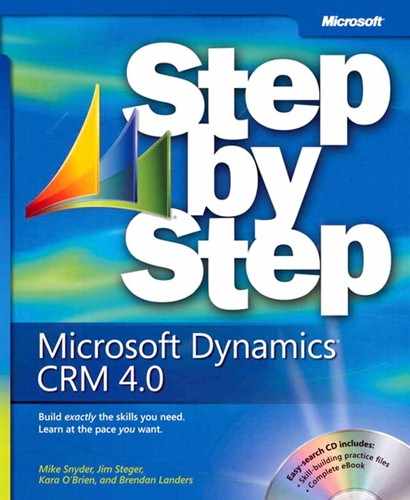Chapter at a Glance
✓ | Create a campaign. |
✓ | Add planning tasks. |
✓ | Select target marketing lists. |
✓ | Add target products and sales literature. |
✓ | Relate campaigns. |
✓ | Create campaign templates. |
✓ | Copy campaign records. |
✓ | Use quick campaigns. |
In Chapter 8, you learned how to use marketing lists to group your customers and prospects into lists. However, marketing lists make up just a small piece of a marketing strategy. After you’ve defined your customer or prospect groups, you can use marketing campaigns in Microsoft Dynamics CRM to communicate with each group and track the responses.
See Also
Chapter 10, discusses how to execute a campaign and track the results with campaign activities and responses, including several reports to measure campaign performance, compare campaigns, and track campaign activities.
A marketing campaign is a series of activities intended to increase awareness of your company, products, or services. As any marketer knows, a properly executed marketing campaign requires coordination of many parties, collateral, and tasks. Microsoft Dynamics CRM provides a convenient way to manage marketing campaigns and their associated activities, tasks, and information.
For instance, suppose you want to launch a new customer loyalty program. This program will reward customers for repeat purchases of your product and entitle them to special discounts and promotions. To initiate the campaign, you plan to send a welcome letter and follow-up e-mail to all qualifying customers, informing them of the program. Some of your tasks might include:
Determining the anticipated costs and expected results of the campaign.
Creating and approving the copy for the welcome letter and e-mail message.
Defining customers to be included in the loyalty program.
Coordinating the graphics and delivery of the letters and e-mail messages with vendors or your IT staff.
Actually sending the campaign-related content to your customers.
Tracking the responses for follow-up activities and analysis.
In this chapter, you will learn how to create a campaign and then associate planning tasks, customer lists, products, and sales literature to it. Further, you will create campaign templates that can be reused in future campaigns. Finally, you will learn how to use the Quick Campaign Wizard in Microsoft Dynamics CRM to quickly create campaign activities for a selected set of leads, contacts, or accounts.
Troubleshooting
Graphics and operating system–related instructions in this book reflect the Windows Vista user interface. If your computer is running Windows XP and you experience trouble following the instructions as written, refer to the "Information for Readers Running Windows XP" section at the beginning of this book.
Important
The images used in this book reflect the default form and field names in Microsoft Dynamics CRM. Because the software offers extensive customization capabilities, it’s possible that some of the record types or fields have been relabeled in your Microsoft Dynamics CRM environment. If you cannot find the forms, fields, or security roles referenced in this book, contact your system administrator for assistance.
Important
You must know the location of your Microsoft Dynamics CRM Web site to work the exercises in this book. Check with your system administrator to verify the Web address if you don’t know it.
Microsoft Dynamics CRM allows you to track marketing or outreach program information on a campaign record. You can track the offer, type, schedule, and financial information about the campaign. For instance, you might have a campaign that coordinates the advertising activities planned for the launch of a new product.
By default, the fields in the following table are tracked on campaigns and campaign templates in Microsoft Dynamics CRM.
Field | Description |
|---|---|
Name | This field contains the title of the campaign. |
Status Reason | This denotes the status of the campaign for reporting purposes. The default statuses are Proposed, Ready To Launch, Launched, Completed, Canceled, and Suspended. |
Campaign Code | This can be either a user-entered or system-generated code for the campaign. |
Campaign Type | This provides a category for the campaign, such as Advertisement, Direct Marketing, Event, or Co-branding. This field is useful in reporting. |
Expected Response | This allows you to record the expected response for a campaign as a percentage from 0 through 100. |
Total Cost of Campaign Activities | In this field, Microsoft Dynamics CRM automatically totals the costs of all campaign activities. |
Miscellaneous Costs | This field records miscellaneous costs associated with the campaign. |
Total Cost of Campaign | This field contains the sum of the total cost of campaign activities and miscellaneous costs. |
In this exercise, you will create the campaign record that will be used to coordinate the advertising activities of your new product launch.
Note
BE SURE TO use the Windows Internet Explorer Web browser to navigate to your Microsoft Dynamics CRM Web site before beginning this exercise.
In the Marketing area, click Campaigns.
In the grid toolbar, click the New button.
The New Campaign form opens.
In the Name field, enter New Product Advertising. In the Status Reason field, select Proposed and in the Campaign Type field, select Advertisement. In the Expected Response field, enter 100 and in the Offer field, enter To boost sales of our product.
Click the Save button to create the campaign.



